OutdoorAdv
Bronze Member
- Joined
- Apr 16, 2013
- Messages
- 2,457
- Reaction score
- 3,351
- Golden Thread
- 1
- Location
- East Coast - USA
- 🥇 Banner finds
- 1
- Detector(s) used
- XP Deus,
GPX 4500,
Equinox 800,
AT Max
- Primary Interest:
- Metal Detecting
I got out a few days after work last week for a total of about 10 hours of hunting at a few different spots. I scored a well worn, but still ID-able King George I half penny. I also got a beautiful hand wrought complete hoe blade from a colonial site. I dug a second one at the same site, however it was broken in half. The worlds tiniest thimble also made an appearance and the hand made bricks I brought home to use in my displays. I also cleaned up a tin cup that wasnt far from the KG copper... its crushed, but old and cool looking.
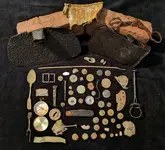
This is my first colonial copper of the year and its an early one. A small right facing bust with "IVS" still visible above King George. I may be able to clean the reverse some more and possibly get a date, but there's such a small date range these were made.
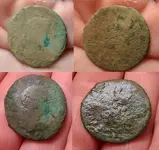
I was very happy to pull this from an elbow deep hole. I put it through electrolysis this weekend and it just came out of the hot wax. There were two hand wrought nails through the neck when I dug it. I suppose they used them as the wedge in the handle. They're pretty far gone, but I have them in the garage and I might try and tumble them later on.
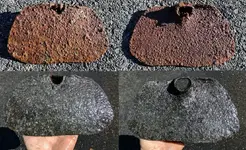
This ax turned up at a different spot where the IHPs came from. I believe its from the second half of the 19th century and they used two bolts through the eye as a wedge in its wooden handle. The bolts are still jammed in there.
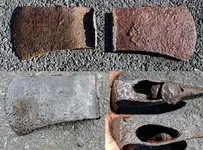
This tin cup isn't the type of thing I typically keep, however I noticed it still had its handle so I decided to try and do something with it. This was close to the KG and hoe blade and I believe its also colonial and similar to the picture from "Collectors Illustrated Encyclopedia of The American Revolution". The handle is bent on the edges in the same way and its soldered in a similar fashion. I stuck it in oxalic acid for about 24 hours and it cleaned up nicely.
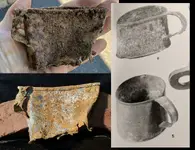
This pocket knife was a HUGE surprise. I was looking through my iron pile yesterday and pulled out this concretion that I assumed was just a hunk of iron from something... then I noticed wood grain on it. I grabbed my tack hammer and lightly tapped it and the concretion broke off reveling a very well preserved wood handle pocket knife I don't even remember which spot this one came from, but if I had to guess, I'd say its 1850's or so. This is the second time I've found a concretion that was protecting preserved wood. I think it might have something to do with the interaction of wood and iron in wet soil.. you can see rocks embedded like concrete in the concretion. After chipping it out and using a dental pick to clean it up, I gave it two coats of Tung Oil to solidify it.
I don't even remember which spot this one came from, but if I had to guess, I'd say its 1850's or so. This is the second time I've found a concretion that was protecting preserved wood. I think it might have something to do with the interaction of wood and iron in wet soil.. you can see rocks embedded like concrete in the concretion. After chipping it out and using a dental pick to clean it up, I gave it two coats of Tung Oil to solidify it.
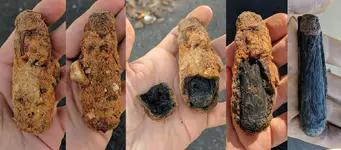
The was the best signal I heard in a while and when I saw a round thing I was thinking it was a BIG copper. I knew it wasnt another watch, but thought either a compact, however with the loop on it I was HOPEFUL it was a compass. I was able to pry it open and... compass it was! It's the most modern find of the bunch, but I was still happy to dig something so unique. It says "West Germany" on it, which helped me narrow the date range and after googling some it appears to be 1950's or so.
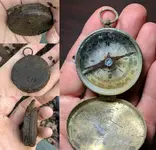
This long skinny brass piece also came from the KG site. Its hammered on one end with a crude hole. On the other end it was cut down the middle of the square rod and split to form a Y with a small iron pin at the end of the Y. (obviously half of the Y is missing) I'm calling it a handle to a candle snuffer with a bell on it, where the bell would have pivoted between the Y split.
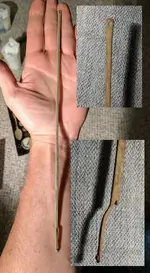
Similar to this one, however what I found is much more basic and I cant find a less fancy one to compare it to. I'm open to any other suggestions on what it might be though.
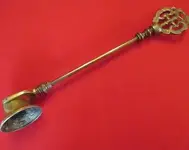
This is the smallest thimble I've ever seen! The buttons are for size comparison. I am guessing either a child's toy, or a thimble for a 5 year old (or so) to learn sewing.
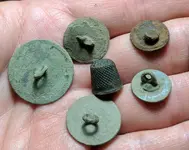
A couple nice rose heads from the KG site that I tumbled.
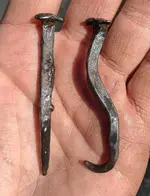
Better pictures of the group
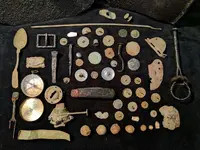
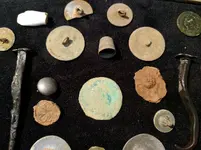
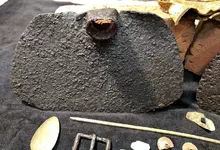
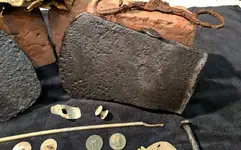
This scythe handle with the brass ferrule attached was a cool thing to dig. I've found the pieces separate, but never still together.
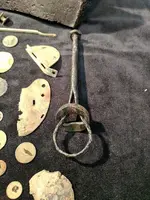
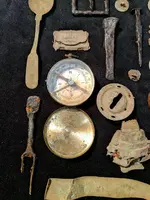
The oil lamp still has its wick in it.
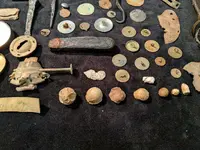
Its incredible to see the wood grain in this preserved pocket knife.
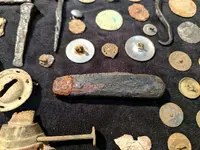
A few pewter buttons turned up and one has a nice design on it (left of KG). Also a cool cuff sized domed tombac.
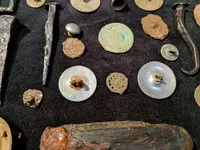
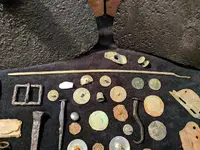
... and the iron and trash (some is still in electrolysis and not in this post)
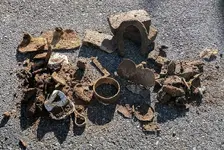
This was a hunt from Sat April 1st using only my GPX. It wasnt enough for me to post it then, so I'm tacking it on this post. After the DIV hunt, I felt like I knew the GPX so much better and gave it another spin at a hard hit site of mine. I didn't do too bad, however I didn't take a picture of the iron and this small handful represented 4 hours of hunting. The reality is that a deep nail or a bent nail sounds just like a good target. I can tell most iron and some nails, but to hunt around a house with a GPX is a lot of digging. It shines relic hunting at DIV hunts where occupancy was limited to a brief time and not spanning 100's of years like around a house. However, I still feel like I know the machine much better now and it is awesome to have in my arsenal.
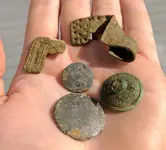
One of the etched tombacs was a close match to two others I dug there in the past. They're all the same pattern, but just slightly different in their etching.
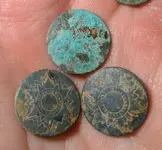
Thanks for looking and happy hunting everyone

This is my first colonial copper of the year and its an early one. A small right facing bust with "IVS" still visible above King George. I may be able to clean the reverse some more and possibly get a date, but there's such a small date range these were made.

I was very happy to pull this from an elbow deep hole. I put it through electrolysis this weekend and it just came out of the hot wax. There were two hand wrought nails through the neck when I dug it. I suppose they used them as the wedge in the handle. They're pretty far gone, but I have them in the garage and I might try and tumble them later on.

This ax turned up at a different spot where the IHPs came from. I believe its from the second half of the 19th century and they used two bolts through the eye as a wedge in its wooden handle. The bolts are still jammed in there.

This tin cup isn't the type of thing I typically keep, however I noticed it still had its handle so I decided to try and do something with it. This was close to the KG and hoe blade and I believe its also colonial and similar to the picture from "Collectors Illustrated Encyclopedia of The American Revolution". The handle is bent on the edges in the same way and its soldered in a similar fashion. I stuck it in oxalic acid for about 24 hours and it cleaned up nicely.

This pocket knife was a HUGE surprise. I was looking through my iron pile yesterday and pulled out this concretion that I assumed was just a hunk of iron from something... then I noticed wood grain on it. I grabbed my tack hammer and lightly tapped it and the concretion broke off reveling a very well preserved wood handle pocket knife
 I don't even remember which spot this one came from, but if I had to guess, I'd say its 1850's or so. This is the second time I've found a concretion that was protecting preserved wood. I think it might have something to do with the interaction of wood and iron in wet soil.. you can see rocks embedded like concrete in the concretion. After chipping it out and using a dental pick to clean it up, I gave it two coats of Tung Oil to solidify it.
I don't even remember which spot this one came from, but if I had to guess, I'd say its 1850's or so. This is the second time I've found a concretion that was protecting preserved wood. I think it might have something to do with the interaction of wood and iron in wet soil.. you can see rocks embedded like concrete in the concretion. After chipping it out and using a dental pick to clean it up, I gave it two coats of Tung Oil to solidify it.
The was the best signal I heard in a while and when I saw a round thing I was thinking it was a BIG copper. I knew it wasnt another watch, but thought either a compact, however with the loop on it I was HOPEFUL it was a compass. I was able to pry it open and... compass it was! It's the most modern find of the bunch, but I was still happy to dig something so unique. It says "West Germany" on it, which helped me narrow the date range and after googling some it appears to be 1950's or so.

This long skinny brass piece also came from the KG site. Its hammered on one end with a crude hole. On the other end it was cut down the middle of the square rod and split to form a Y with a small iron pin at the end of the Y. (obviously half of the Y is missing) I'm calling it a handle to a candle snuffer with a bell on it, where the bell would have pivoted between the Y split.

Similar to this one, however what I found is much more basic and I cant find a less fancy one to compare it to. I'm open to any other suggestions on what it might be though.

This is the smallest thimble I've ever seen! The buttons are for size comparison. I am guessing either a child's toy, or a thimble for a 5 year old (or so) to learn sewing.

A couple nice rose heads from the KG site that I tumbled.

Better pictures of the group




This scythe handle with the brass ferrule attached was a cool thing to dig. I've found the pieces separate, but never still together.


The oil lamp still has its wick in it.

Its incredible to see the wood grain in this preserved pocket knife.

A few pewter buttons turned up and one has a nice design on it (left of KG). Also a cool cuff sized domed tombac.


... and the iron and trash (some is still in electrolysis and not in this post)

This was a hunt from Sat April 1st using only my GPX. It wasnt enough for me to post it then, so I'm tacking it on this post. After the DIV hunt, I felt like I knew the GPX so much better and gave it another spin at a hard hit site of mine. I didn't do too bad, however I didn't take a picture of the iron and this small handful represented 4 hours of hunting. The reality is that a deep nail or a bent nail sounds just like a good target. I can tell most iron and some nails, but to hunt around a house with a GPX is a lot of digging. It shines relic hunting at DIV hunts where occupancy was limited to a brief time and not spanning 100's of years like around a house. However, I still feel like I know the machine much better now and it is awesome to have in my arsenal.

One of the etched tombacs was a close match to two others I dug there in the past. They're all the same pattern, but just slightly different in their etching.

Thanks for looking and happy hunting everyone

Last edited:
Upvote
37





